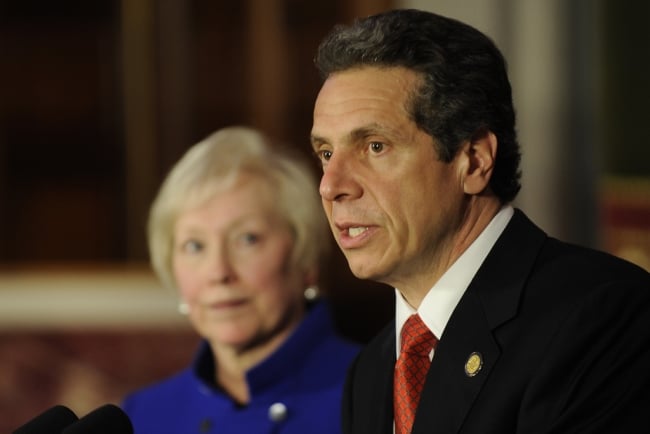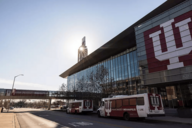You have /5 articles left.
Sign up for a free account or log in.

SUNY Chancellor Nancy Zimpher and New York Governor Andrew Cuomo
New York Governors Office
Since Eastman Kodak, formerly the largest employer in the city of Rochester, began its slow slide toward bankruptcy, another player has stepped into the space as the region’s largest employer and a major economic driver: the University of Rochester.
“I’m president of a large, diversified institution, and in this role I feel a symbiotic relationship with the City of Rochester and the region,” said University of Rochester President Joel Seligman. “We know that if the region thrives more economically, then that will help us, and vice versa. That has been the reason why I spend so much time focusing on this. I don’t know of any more important obligation I have.”
Along with Rochester Institute of Technology President William W. Destler, Monroe County Community College President Anne M. Kress and a handful of other educational, civic and business leaders, Seligman has engaged in multiple efforts to help sustain the region's economy, such as the local regional economic development council.
The state’s political leadership is now looking to tap into the civic spirit of its public and private higher education institutions and take those relationships one step further. Last month the state passed a law that will create tax-free zones on and around the institutions of the State University of New York system as well as some campuses of the City University of New York and private colleges in the state to house companies with some tie to those institutions’ educational missions. Such businesses would be exempt from various state (but not necessarily local) taxes, and their employees would not be charged state income tax, a dramatic decrease in what many consider a high-tax state. The state's corporate income tax rate is 7.1 percent, and income over about $20,000 for individuals and about $40,000 for couples is taxed at a rate of at least 6 percent.
“There is no state in the country that will have an advantage over these areas,” said New York Governor Andrew Cuomo in announcing the plan in Buffalo in May. “There’s no reason to leave. No one can offer you a better tax package than we can on that site.”
The plan is designed to help foster and retain startup companies; motivate companies within the state to expand; and potentially lure out-of-state companies to upstate New York, a region that has struggled economically for the past few decades as its traditional industries, such as manufacturing, have declined.
 The New York plan – referred to at various times as “Tax Free NY” and “Start Up NY” – is one of the more ambitious proposals in recent years to stimulate economic development around public and private colleges. Such strategies have become increasingly popular, particularly since the 2008 recession, as institutions try to assert their relevance (and stave off state funding cuts) and states look to stimulate their economies using existing infrastructure rather than investing in new projects. The SUNY plan is distinct in that it not only places universities at the geographic center of such efforts, but also foists upon them a responsibility for convening and coordinating such efforts. Administrators say such a role is an expansion of one they currently see themselves playing.
The New York plan – referred to at various times as “Tax Free NY” and “Start Up NY” – is one of the more ambitious proposals in recent years to stimulate economic development around public and private colleges. Such strategies have become increasingly popular, particularly since the 2008 recession, as institutions try to assert their relevance (and stave off state funding cuts) and states look to stimulate their economies using existing infrastructure rather than investing in new projects. The SUNY plan is distinct in that it not only places universities at the geographic center of such efforts, but also foists upon them a responsibility for convening and coordinating such efforts. Administrators say such a role is an expansion of one they currently see themselves playing.
“‘Tax-free NY’ will do more to position SUNY as the state's economic engine than we have ever seen, or dared imagine,” wrote Nancy Zimpher, chancellor of the State University of New York system, in an op-ed in June. State officials said Zimpher, who has publicly championed the role the system can play in the state's economic development, has been instrumental in positioning SUNY as a central force in the governor's plans.
"This really puts us in the forefront of revitalizing the community and making it attractive to businesses," said Kevin Kearns, vice president engagement and economic development at SUNY-Fredonia.
While administrators say they have heard from several out-of-state companies interested in relocating to one of the tax-free regions when the program formally begins on January 1, 2014, they say it is much too soon to evaluate whether the program will be effective. Economic development professionals say such plans tend to hinge less on the design of a program than whether there is sufficient leadership to carry them out and whether they can generate the community engagement necessary to support such efforts.
“There has to be more than just a plot of land,” said Jason Lane, an education policy professor at SUNY-Albany who has researched economic development efforts. “You have to have somebody to shepherded and nurture and support new businesses and help them grow.”
Common Playbook (With Modifications)
New York is not the first state, nor is it likely to be the last, to pin hopes for economic development on higher education institutions. There is a long track record of both formal efforts -- such as North Carolina’s Research Triangle Park, based around Duke University, North Carolina State University and the University of North Carolina at Chapel Hill -- to tap into university research as a spur for company and job creation.
Economic development professionals said there is a lot of logic behind such efforts. In addition to the potential to commercialize university research, higher education institutions often draw large numbers of people to a region, create pools of high-skilled labor, attract research dollars, are attractive places to live and fare well during economic downturns.
“Universities offer such a focal point in an area in terms of everything from resources to opportunities,” said Richard Overmoyer, executive director of the Pittsburgh-based University Economic Development Association. “They’re not necessarily recession-proof, but in a lot of communities they are the leading employers. They have major purchasing power that can impact local economics, and can have a profound impact with their decisions.”
But for every Research Triangle Park there are countless efforts that either failed or produced only marginal success. In the early 2000s, Overmoyer oversaw the development of the Keystone Innovation Zones in Pennsylvania, a program that provided tax credits to companies in particular geographic regions. The state established 29 zones in the first year of the program, 2004, and several have proven hugely successful and continue. But Overmoyer said the majority are not headline-generating efforts, which he said is not unusual for economic development initiatives.
Overmoyer and others said the initiatives that prove successful are the ones that generate an interested community in the designated regions that can sustain the program beyond the initial investment. Often times such efforts fail because resources are pulled back, either because state or local leadership changes or because such strategies do not show immediate results.
“The question is really whether leadership is fostering a collaborative environment,” Overmoyer said. “No economic development can happen on its own. It needs a leader who can convene people, and also a long-term commitment of resources, because you don’t see an immediate benefit. You have got to have some patience.”
In 2010, the Rockefeller Institute, based in Albany, N.Y., released a report conducted at the request of Zimpher to explore the role universities could play in economic development. Unlike 20th century economic development policies, which were primarily based on providing incentives like tax breaks and infrastructure improvements, "The 21st century paradigm, in contrast, is shifting toward putting knowledge first," the report states. "For states, increasingly, that means connecting their higher education systems more closely to their economic development strategies."
Tax Free NY
 The new tax-free zones builds on several initiatives Cuomo and the state legislature have put in place in recent years. Most of those initiatives are designed to foster regional collaboration and tie universities to the businesses in the area.
The new tax-free zones builds on several initiatives Cuomo and the state legislature have put in place in recent years. Most of those initiatives are designed to foster regional collaboration and tie universities to the businesses in the area.
Soon after coming into office, the governor established 10 regional economic development councils, all co-chaired by a state or private university leader and a local business leader. Over the past few years, the state has awarded capital funding, tax credits and state dollars to plans established through the councils, including business incubators at the colleges and universities.
The universities themselves have also taken steps to get more engaged in economic development over the past few decades. "We realized that our community is part of who we are and vice versa," Kearns said. "It has been a gradual evolution of increased commitment to engagement in the community. It was also a very conscious decision. Dunkirk (a nearby city) has fallen on hard time, like a lot of the economically depressed northeast, and we made a conscious decision to have a presence in that community to help revitalize the region."
Kearns said SUNY-Fredonia has housed about about 15 startups in its incubator in the past few years, creating about 65 jobs in the community. It has also created the opportunity for students to take on internships with these companies.
While several of these projects have produced startup companies, higher education administrators said a large number of the companies have moved out of New York to states with “more favorable tax policies,” such as North Carolina and Texas. “The state has a reputation as a high-tax state,” Destler said. “I’m, not sure it’s entirely earned, but these reputations are hard to shake.”
Texas Governor Rick Perry recently ran advertisements in New York telling companies that they should relocate to Texas for lower taxes. In some respects, the tax-free zones are an effort to combat such efforts.
“Cuomo gets it,” Seligman said. “In the 21st century, we’re going to see very intense competition among the states. When he sees the success of someone like Governor Perry attracting businesses from New York, that gives him heartburn. He understands that we need new mechanisms, and the tax-free zones are part of that.”
The tax-free program will be open to startup companies; companies from out of state that relocate to New York; or existing New York companies that are expanding (but not simply moving). Companies will have to have a partnership with an educational institution and will have “to be aligned with or further the academic mission of the campus.”
Those companies will have to set up shop on vacant land on SUNY campuses, in vacant space in buildings on SUNY campuses, in business incubators associated with universities or within one mile of a campus (with some exceptions).
The program will also allocate up to 3 million square feet that the private universities to tap into provided it meets similar parameters. Some space associated with the City University of New York will also be designated for the project, though administrators said the real focus is to focus on upstate development.
Companies that qualify for the program will not pay any state taxes for 10 years. Employees in those companies will pay no income taxes for the first five years. For the second five years, they will pay no taxes under certain levels (such as $200,000 for individuals).
Economic development professionals said that while the use of tax-free zones is not unusual, the location of New York’s zones makes that plan distinct. “We tend not to see tax-free zones placed in high-quality areas,” Lane said. “Normally tax-free zones are in transportation districts and they’re used to revitalize really bad areas. I’ve never seen tax-free zones placed in really high-quality areas that business would want to relocate to anyway.”
Reception
The plan has been met with near-universal praise by the state’s higher education leadership, including its public and private university presidents. The leadership from all of SUNY’s 64 campuses (now 65) signed a letter of support for the proposal.
“This is an unequivocally good thing,” Seligman said.
Officials said they have spent much of their time this summer trying to determine how they will deploy the zones. Several institutions said they will look to have their university-related business incubators incorporated into the program, and others have mentioned business parks. “We have a research park, 240 acres, right across the street from our campus,” Stanley said. “That is ideally positioned to take advantage of this.”
 Seligman and Destler said the Rochester region has been considering what to do with the Eastman Business Park, a manufacturing and industrial complex in Rochester that has been used by Kodak. The Start Up NY plan will likely factor into that park’s future.
Seligman and Destler said the Rochester region has been considering what to do with the Eastman Business Park, a manufacturing and industrial complex in Rochester that has been used by Kodak. The Start Up NY plan will likely factor into that park’s future.
The tax-free plan is likely to build on existing regional strengths, and administrators said they were working to nail down more strategic direction. The efforts of Rochester institutions will likely include optics, a traditional strength for the region. Officials at SUNY-Buffalo said they will likely focus some of their efforts on the biomedical industry. Stony Brook officials said pharmaceuticals, aviation and advanced manufacturing are likely to be some of their areas of focus.
Kearns said he has already heard from individuals in the Fredonia-Dunkirk community interested in contributing to the effort in various ways, including potentially contributing real estate and office buildings to the university that could house companies attracted to the region.
But there were several groups who were not supportive of the plan and how quickly it went through the legislature. (The plan took less than two months to get legislative approval.)
“There was no real public debate about this,” said Stephen Madarasz, director of communications for the Civil Service Employees Union, which opposed the plan. “It was foisted on everybody at the last minute.”
Faculty groups and some state employee unions, which see the tax-free zones as a handout to special interests and a shift in the university’s orientation away for pure academics toward "corporatization," pushed back against the plan. Some faculty members argue that investing directly in SUNY institutions is a more tested approach that would provide more long-term benefit.
“We should be putting money into the enterprises that actually do spur economic development,” said Lawrence Wittner, an emeritus professor of history at SUNY-Albany who has been outspoken in opposition to the plan. “Things like public education, health care, parks and a whole range of other facilities.”
Pushback from business owners already located in New York, who argued that the plan was not fair since state residents would be taxed at different rates, even on their income, also drove the governor’s office to change the name of the plan midway through the legislature. Instead of going by “Tax-Free NY,” the program would be called “Start Up NY,” but changes to the plan were minimal.
New Jobs
While the state’s plan is primarily designed to spur job creation in upstate New York, development and university professionals say it could also result in a reimagined role for the state’s universities – particularly the publics – in the state’s economy.
“It raises the awareness of what SUNY can contribute to the state,” Lane said. “In many of the communities upstate, these universities are the last remaining anchor institution. SUNY and some of the independents are the largest employers and purchasers of goods in many of these areas. The governor is reframing the story. Instead of these being access institutions in New York, they’re the real driver of the New York economy and its future. This could be an important turning point in how government and citizens see SUNY and how SUNY sees SUNY.”
Several university presidents, like Seligman at Rochester, said this is a role they have already been filling in their communities. But the tax-free zones and other policy changes that accompanied the plan provide an additional tool through which institutions can further engage in such practices.
“For Stony Brook, this is not a new mission,” said Samuel L. Stanley, Stony Brook’s president. “It is something we’ve been engaged in for a number of years. This is just a chance to expand what we do. As a state institution, there’s an expectation that we’ll help in economic development."
"Our missions as a comprehensive college is to sometimes broaden that mission and reflect the needs of the community," Kearns said. "And we have to find a way to incorporate that into our curriculum and what we do every day."
The presidents said they did not believe the new responsibilities associated with the plan would complicate their jobs. Seligman said the story of higher education leadership over the past few decades has been one of shifting orientation from inside the institution to outside, with presidents engaging in more community development, fund-raising and political activity, rather than day-to-day campus management.
Successful collaboration between university and industry can also provide more champions for higher education when it comes time to shape state budgets, Lane said, pointing to the involvement of the Texas business community in political affairs on behalf of the University of Texas.
"The governor has elevated SUNY into a prominent role as part of his policies," Lane said. "The storyline has really changed significantly now."




